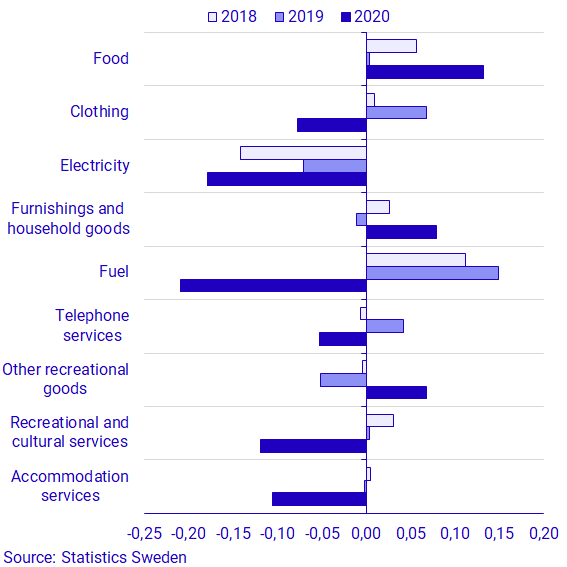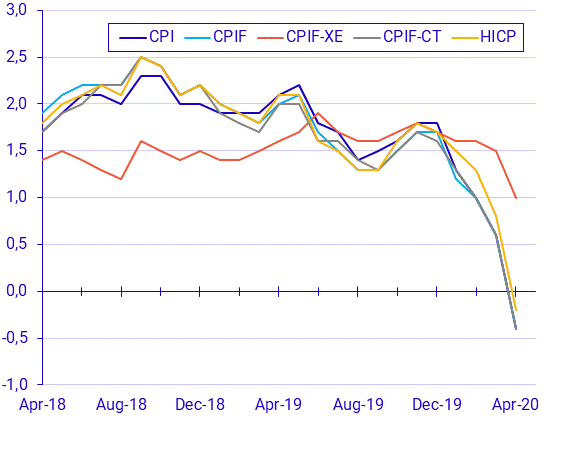Consumer Price Index (CPI), April 2020
Inflation rate fell sharply to -0.4 percent in April 2020
Statistical news from Statistics Sweden 2020-05-13 9.30
The inflation rate according to the CPIF (Consumer Price Index with fixed interest rate) was -0.4 percent in April 2020, down from 0.6 percent in March. The sharp decline in the inflation rate is mainly explained by lower energy prices. The change on a monthly basis between March and April was -0.3 percent.
In brief
| Index Numbers | Monthly changes, percent | Annual changes, percent | |
|---|---|---|---|
| CPI (1980=100) | 332.90 | ‑0.3 | ‑0.4 |
| CPIF (1987=100) | 217.59 | ‑0.3 | ‑0.4 |
| CPIF-XE (1987=100) | 207.02 | 0.1 | 1.0 |
- Lower prices on fuel and electricity affected the inflation rate by -1.3 percentage points
- The inflation rate according to the CPIF, excluding energy, was 1.0 percent
- Large price decreases on clothing, accommodation and recreational services
- Large price increases on food and housing goods
- 3.1 percent of the basket was imputed due to absence of consumption
Electricity and fuel affected the CPIF in April
The CPIF fell by 0.3 percent between March and April. In the corresponding period a year ago, the CPIF increased by 0.6 percent.
The main contribution to the monthly rate came from lower prices on fuel and electricity. Lower prices on accommodation services, clothing, recreational services and telecommunication services also affected the CPIF.
Higher prices on vegetables and fruit, furnishing and household goods, and sporting and outdoor goods offset the price decreases.
The table below shows changes on a monthly basis and effects on the CPIF based on the goods and services that had the largest effect on the CPIF in April 2020. The results are reported per COICOP category; COICOP refers to the United Nations classification of household consumption expenditure.
| Name (Coicop) | Monthly changes, percent | Monthly effect on the CPIF, percentage points |
|---|---|---|
| Food (01.1) | 1.0 | 0.1 |
| Clothing (03.1) | ‑2.1 | ‑0.1 |
| Electricity (04.5.1) | ‑5.1 | ‑0.2 |
| Furnishings and household goods (05) | 1.2 | 0.1 |
| Fuel (07.2.2) | ‑9.0 | ‑0.2 |
| Telephone services (08.3) | ‑2.4 | ‑0.1 |
| Other recreational items (09.3) | 2.5 | 0.1 |
| Recreational and cultural services (09.4) | ‑2.5 | ‑0.1 |
| Accommodation services (12.2) | ‑10.4 | ‑0.1 |

Seasonal patterns and temporary price changes
Price changes for goods and services may be seasonal or temporary. The figure above shows effects on a monthly basis for the goods and services that effected the CPIF the most. Fuel prices fell in April 2020, while in the same period over the last two years, fuel prices rose. In addition, prices on clothing, accommodation and recreational services fell in April, which is a departure from previous years. For sporting and outdoor equipment, prices rebounded following a number of promotional campaigns in the market in March.
Contribution to inflation rate in April
The inflation rate according to the CPIF, that is, the change in the CPIF over the past 12-month period, was -0.4 percent in April 2020, down from 0.6 percent in March.
The largest contribution to the inflation rate in April 2020 came from lower prices on electricity and fuel. Lower prices on clothing and footwear, recreation and culture and communications also affected the inflation rate.
This decrease was offset mainly by price increases on food and non-alcoholic beverages. Prices on restaurants, housing, and miscellaneous goods and services also increased substantially.
| Name (Coicop) | Yearly change, percent | Yearly change effect, percentage points |
|---|---|---|
| Food and non-alcoholic beverages (01) | 3.5 | 0.5 |
| Clothing and footwear (03) | ‑3.8 | ‑0.2 |
| Electricity (04.5.1) | ‑16.4 | ‑0.7 |
| Rented and housing co-operative dwellings: rent incl. heating (04.S) | 1.5 | 0.2 |
| Housing (04.x) | 2.8 | 0.2 |
| Fuel (07.2.2) | ‑20.9 | ‑0.6 |
| Communication (08) | ‑7.5 | ‑0.3 |
| Recreation and culture | ‑1.6 | ‑0.2 |
| Restaurants (11.1) | 2.4 | 0.2 |
| Misc. Goods and services (12) | 2.3 | 0.2 |
Other measures of inflation
Statistics Sweden uses different inflation measures for different purposes. The CPIF is the Riksbank’s target variable, while the CPI is the measure used for purposes of compensation.

Effects of the coronavirus pandemic on calculations
Measures in response to the corona pandemic have led Swedish consumers to adapt parts of their consumption. In some cases, stores have closed, but it remains possible to purchase products elsewhere. In other cases, consumption has ceased completely. These developments make calculating the consumer price index particularly challenging.
Due to a lack of consumption, prices on package holidays, international flights and admission tickets have been imputed, so as not to affect the inflation rate. For further information about measurement problems related to the coronavirus pandemic, see the link below.
Meausurement issues related to the coronavirus pandemic (pdf)
Definitions and explanations
The CPIF shows the same price trend as the CPI, but without the direct effects of a changed monetary policy. The CPIF is the Riksbank’s target variable for the inflation target.
The CPIF excluding energy (CPIF-XE) and the CPIF with constant tax (CPIF-CT) are two other measures of inflation produced by Statistics Sweden on behalf of the Riksbank. In the CPIF-XE, energy products are excluded from the CPIF, while in the CPIF-CT the taxes and subsidies associated with the products in the CPIF are kept constant.
The HICP (Harmonised Index of Consumer Prices) is produced by all EU Member States. This measure has a somewhat smaller coverage than the CPI and the CPIF, mainly because parts of households’ housing costs are omitted.
Next publishing will be
2020-06-11 at 9:30.
Statistical Database
More information is available in the Statistical Database
Feel free to use the facts from this statistical news but remember to state Source: Statistics Sweden.
